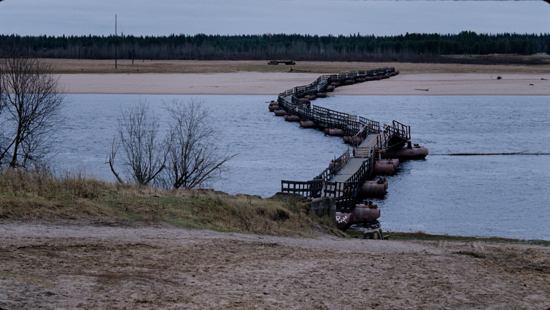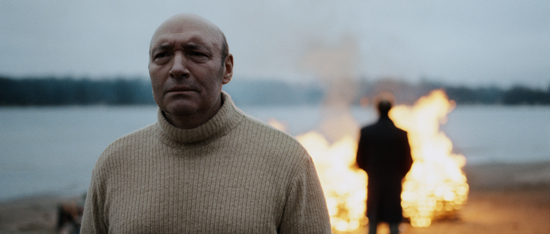Road movies with plots centring on the burial rituals associated with an ancient Finno-Ugric tribe from Lake Nero are about as common as slow cinema epics coming in under the three hour mark. Russian director Aleksei Fedorchenko has calmly and stylishly shattered this inexplicable oversight in world cinema with Silent Souls, a bewitching and beguiling love story told through the frozen landscapes of his country’s western region. An elegantly baroque piece of filmmaking, it manages to weave a mysterious tale of vanishing cultures and personal loss around a solemn middle-aged man named Aist (Igor Sergeyev), his recently bereaved companion Miron (Yuri Tsurilo), a dead wife’s sexual appetites and two caged birds.
Aist is the darkly intoning narrator whose people, the Merya, are ethnic Finns who migrated to the lands north-west of Moscow and were ultimately absorbed by the Russian Slavs. Their culture has become a remnant and their language is extinct, apart from place names which spectrally hover over the maps of the locale. The only other remaining vestiges of their existence are some strange customs – such as the washing and braiding of multiple coloured threads into a girl’s pubic hair before either marriage or cremation – which the Meryans can only vaguely understand themselves. Aist’s own attempts to create a written account of their history repeatedly falls at the same hurdle: how does one document a culture whose voice has been silenced?
In search of a companion to accompany him on the ancient burial pilgrimage for his recently departed wife Tanya (Yuliya Aug), paper mill complex manager Miron decides Aist is the man for the job. The duo set off on their journey in a rusty station wagon, bringing along the buntings Aist has recently purchased. The latter’s sporadic chirping provides the primary soundtrack for what is a solemn journey interrupted by Miron beginning to ‘smoke’ – the revealing of truths concerning a person’s loved ones, which has the effect of turning grief into tenderness – whereby we are assured that "all three of Tanya’s holes were working".
Rather like Nuri Bilge Ceylan’s superb recent Once Upon A Time In Anatolia, the meaning is revealed through an often absurd interior drama which revolves around that very search for meaning. The further the pair travel into the wilderness, the deeper they dig into their past. This quest for enlightenment through the prism of road travel is not an isolated moment within Russian cinema. Boris Khlebnikov and Aleksey Popogrebskiy’s Roads To Koktebel (2003) offered a perhaps too minimal take on grim journeys of the soul, while Andrey Zvyagintsev’s The Return from the same year (also shot by Silent Souls cinematographer Mikhail Krichman) was a more successful sojourn through the primeval wilderness.
Through the vast visual expanse of his latest offering, Fedorchenko has conjured a melancholic but altogether more magic realism which muscles up to vintage Tarkovsky and Parajanov while suggesting a director as much in thrall to literature and photography as to conventional filmmaking. The slow-release cinematography offers an ever revolving cabinet of curiosities to feast on – Miron sensually drenches his naked wife in vodka; Aist’s father hacks through the ice and condemns his typewriter to a frozen lake – while the plot mirrors William Faulkner’s lyrical odyssey through death and burial, As I Lay Dying.

During the course of the journey, Aist makes it clear that major life changes are ahead, which supplies an urgent streak to the unfolding drama. All of a sudden, each meticulously crafted shot and murmured utterance is imbued with grave potential as they prepare Tanya’s funeral pyre. Working with such foreboding and often mundane base material, the efficacy and beauty which Fedorchenko creates is a testament to his talents. However, the sombre intensity is tempered not just by the bouts of fanciful ritual, but also by the director’s own past. He initially came to attention with 2005’s First On The Moon, a wonderfully whimsical mockumentary about a successful Soviet lunar landing in 1938, which raises questions about the trustworthiness of some of the ‘conventions’ depicted in Silent Souls.
But the grace of the film lies within the characters. We feel Miron’s love for Tanya through brief flashbacks of their passionate and often disturbing relationship. Aist, taciturn and reflective, recalls his father, a demented Meryan poet, and relates cryptic details about his own relationship with the deceased. And as it’s gradually made clear that seemingly random incidents are part of some foreordained plan, the film becomes a sort of profound requiem for grief and loss. Silent Souls is very much the work of a storyteller, creating a narrative which uses the road journey as a guide to the received wisdom of an entire community, no matter how imaginary.



